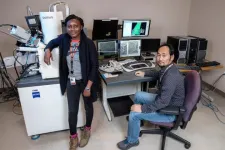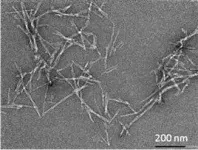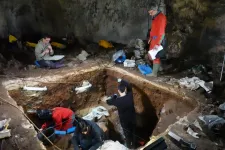Modelling ancient antarctic ice sheets helps us see future of global warming
New research from UMass Amherst gives clearer picture of mid-Miocene Antarctic ice sheet
2021-04-15
(Press-News.org) AMHERST, Mass. - Last month saw the average concentration of atmospheric carbon dioxide (CO2) climb to almost 418 parts-per-million, a level not seen on Earth for millions of years. In order to get a sense of what our future may hold, scientists have been looking to the deep past. Now, new research from the University of Massachusetts Amherst, which combines climate, ice sheet and vegetation model simulations with a suite of different climatic and geologic scenarios, opens the clearest window yet into the deep history of the Antarctic ice sheet and what our planetary future might hold.
The Antarctic ice sheet has attracted the particular interest of the scientific community because it is "a lynchpin in the earth's climate system, affecting everything from oceanic circulation to climate," says Anna Ruth Halberstadt, a Ph.D candidate in geosciences and the paper's lead author, which appeared recently in the journal Earth and Planetary Science Letters. Additionally, the ice sheet contains enough frozen water to raise current sea levels by 57 meters.
Yet, it has been difficult to accurately reconstruct the mid-Miocene Antarctic climate. Researchers can run models, but without geologic data to check the models against, it's difficult to choose which simulation is correct. Conversely, researchers can extrapolate from geologic data, but such data points offer only local snapshots, not a wider climatic context. "We need both models and geologic data to know anything at all," says Halberstadt. There's one final complicating factor: geology. Antarctica is bisected by the Transantarctic Mountains, and any clear picture of Antarctica's deep history must be able to account for the slow uplift of the continent's mountain range. "Without knowing the elevation," says Halberstadt, "it's difficult to interpret the geologic record."
Halberstadt and her colleagues, including researchers in both New Zealand and the UK, devised a unique approach in which they coupled an ice sheet model with a climate model, while also simulating the types of vegetation that would grow under each climatic model scenario. The team used historical geologic datasets that included such known paleoclimatic data points as past temperature, vegetation, and glacial proximity, to benchmark their modeled climates. Next, the team used their benchmarked model runs to make inferences about which CO2 and tectonic model scenarios satisfied the known geologic constraints. Finally, Halberstadt and her colleagues extrapolated continent-wide glacial conditions.
The research, which was supported by the NSF, reconstructed a thick but diminished ice sheet under the warmest mid-Miocene environmental conditions. In this model, although the margins of Antarctica's ice sheet had retreated significantly, greater precipitation led to a thickening of the ice sheet's interior regions. The team's modelling further suggests ice over the Wilkes Basin region of Antarctica advanced during glacial periods and retreated during interglacials. The Wilkes Basin is the region thought to be particularly sensitive to future warming and may contribute to future sea level rise.
"Antarctica's paleoclimate," says Halberstadt, "is fundamental to understanding the future."
INFORMATION:
Contacts: Anna Ruth Halberstadt, ahalberstadt@umass.edu
Daegan Miller, drmiller@umass.edu
[Attachments] See images for this press release:

ELSE PRESS RELEASES FROM THIS DATE:
2021-04-15
Financial stress can have an immediate impact on well-being, but can it lead to physical pain nearly 30 years later? The answer is yes, according to new research from University of Georgia scientists.
The study, published in Stress & Health, reveals that family financial stress in midlife is associated with a depleted sense of control, which is related to increased physical pain in later years.
"Physical pain is considered an illness on its own with three major components: biological, psychological and social," said Kandauda A.S. Wickrama, first author and professor in the College of Family and Consumer Sciences. "In older adults, it co-occurs with other health problems like limited physical functioning, loneliness and cardiovascular ...
2021-04-15
Florida State University researchers have discovered a novel way to improve the performance of electrical wires used as high-temperature superconductors (HTS), findings that have the potential to power a new generation of particle accelerators.
An image of Bi-2212, bismuth-based superconducting wires. (Mark Wallheiser/FAMU-FSU College of Engineering)
Researchers used high-resolution scanning electron microscopy to understand how processing methods influence grains in bismuth-based superconducting wires (known as Bi-2212). Those grains form the underlying ...
2021-04-15
Amyloid fibrils are deposits of proteins in the body that join together to form microscopic fibres. Their formation has been linked to many serious human diseases including Alzheimer's, Parkinson's and Type 2 diabetes.
Until today, scientists have been unable to reliably measure the speed of fibril growth, as there have been no tools that could directly measure growth rate in solution. However, researchers from the UK's University of Bath and the ISIS Neutron and Muon Source have now invented a technique that does just that. Results from their study are published in RSC Chemical Biology.
"This is an important breakthrough, ...
2021-04-15
In a newly released study, researchers found that remote and virtual care models can negatively impact small physician offices. Three researchers from END ...
2021-04-15
To better understand the psychological and physical impact caused by the profound consequences of the COVID-19 pandemic - and also inform priorities for interventions and policy changes to address the mental health consequences of the pandemic -- researchers from the Center for the Developing Brain at the Child Mind Institute developed and deployed the CoRonavIruS health and Impact Survey (CRISIS). This questionnaire covered key topics relating to mental distress and resilience during the pandemic. According to a newly-published manuscript of the findings, perceived risk of COVID-19, prior mental health status, and lifestyle changes were key predictors of mental health during the pandemic in adults and children surveyed in the U.S. and U.K.
In the study, supported by the Morgan Stanley ...
2021-04-15
URBANA, Ill. - Agricultural producers deal firsthand with changing weather conditions, and extreme events such as drought or flooding can impact their productivity and profit. Climate change models project such events will occur more often in the future. But studies of the economic consequences of weather and climate on agriculture typically focus on local impacts only.
A new study from the University of Illinois looks at how changes in weather - including extreme events - may decrease crop profit in one state while increasing profits in other states. The secret ingredient: U.S. interstate trade. It is expected to mitigate ...
2021-04-15
The field of ancient DNA has revealed important aspects of our evolutionary past, including our relationships with our distant cousins, Denisovans and Neandertals. These studies have relied on DNA from bones and teeth, which store DNA and protect it from the environment. But such skeletal remains are exceedingly rare, leaving large parts of human history inaccessible to genetic analysis.
To fill these gaps, researchers at the Max Planck Institute for Evolutionary Anthropology developed new methods for enriching and analyzing human nuclear DNA from sediments, which are abundant at almost every archaeological site. Until now, only ...
2021-04-15
The widespread proliferation of the internet and information and communication technologies (ICT) has drawn people into urban centres, according to new research.
Despite being able to access data at the drop of a hat or speak face-to-face to people on the other side of the world, the evolution of technological capabilities hasn't led to an exodus from cities. In fact experts at the University of Bristol have found quite the opposite; that the increased adoption of ICT has resulted in national urban systems - cities within a country - that are characterised by higher population concentrations. ...
2021-04-15
A new generation of miniature recording probes can track the same neurons inside tiny mouse brains over weeks -- and even months.
The new tools build on the success of the original Neuropixels probes released in 2017 and currently used in more than 400 labs. Neuropixels 2.0 are much smaller -- about a third the size of their predecessors. They're designed to record the electrical activity from more individual neurons and have the unique ability to track this activity over extended time periods. That makes them especially useful for studying long-term phenomena like learning and memory in small animals such as mice, says Tim Harris, a senior fellow at HHMI's Janelia Research Campus who led the project. Harris and his colleagues describe the advance in a paper published online ...
2021-04-15
Irvine, Calif., -- By analyzing gains and losses in the genes of phytoplankton samples collected in all major ocean regions, researchers at the University of California, Irvine have created the most nuanced and high-resolution map yet to show where these photosynthetic organisms either thrive or are forced to adapt to limited quantities of key nutrients, nitrogen, phosphorus and iron.
As part of the new Bio-GO-SHIP initiative, the UCI scientists made eight deployments on six different research vessels, spending 228 days at sea in the Atlantic, Pacific and Indian oceans. They generated nearly 1,000 ocean metagenomes from 930 locations around the globe, with an average distance between collection points at 26.5 kilometers (about 16.5 miles). ...
LAST 30 PRESS RELEASES:
[Press-News.org] Modelling ancient antarctic ice sheets helps us see future of global warming
New research from UMass Amherst gives clearer picture of mid-Miocene Antarctic ice sheet




